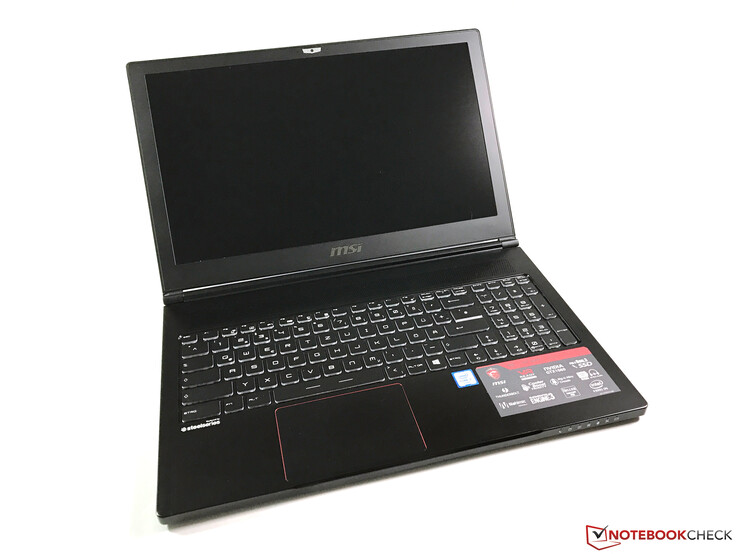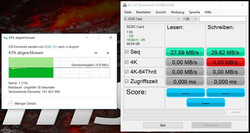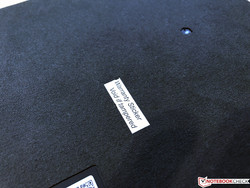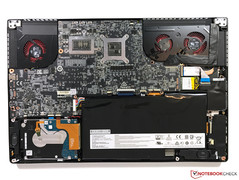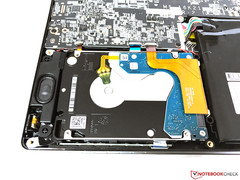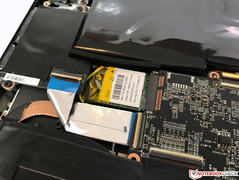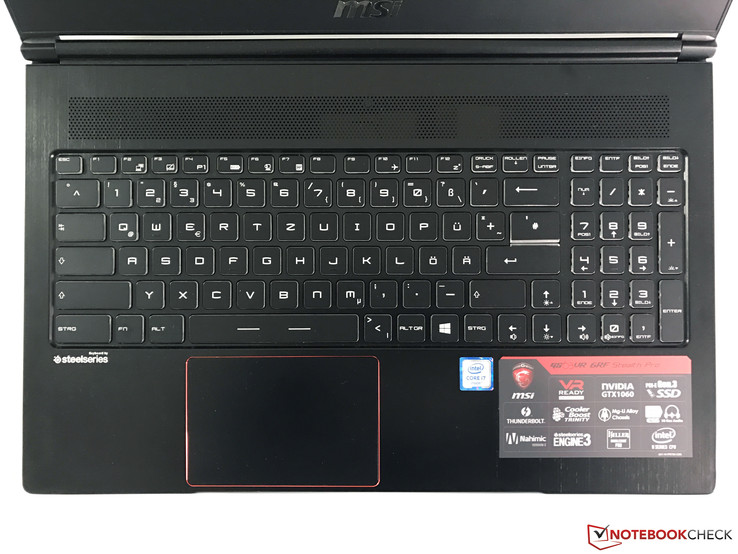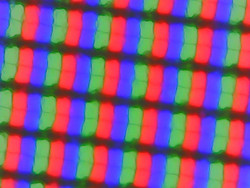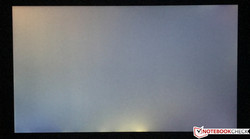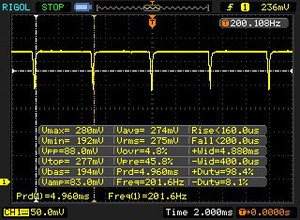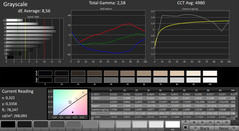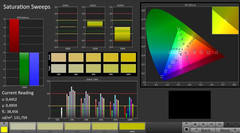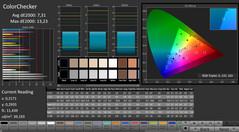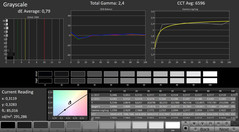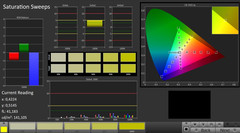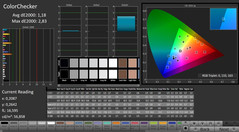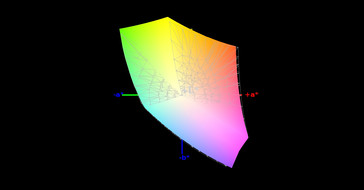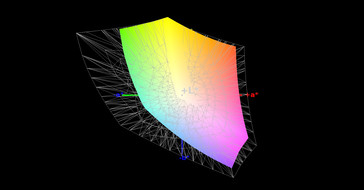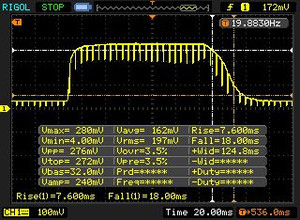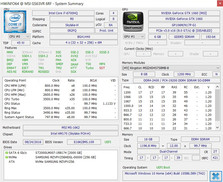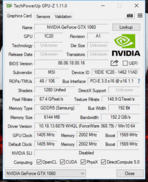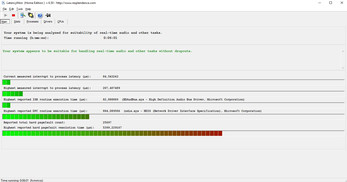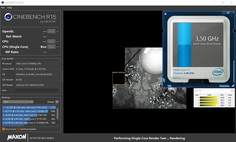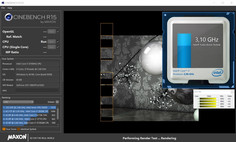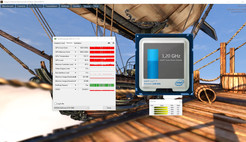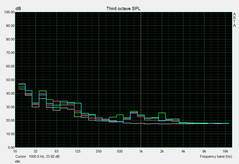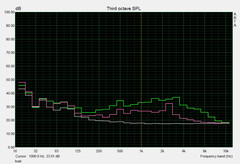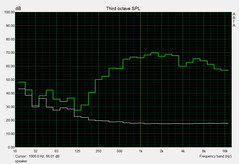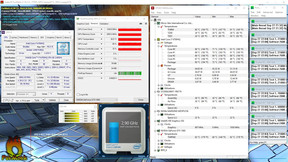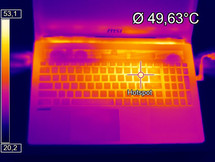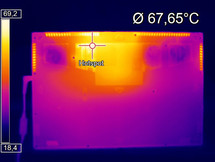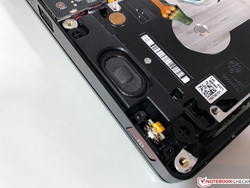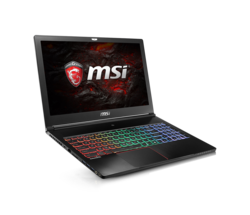MSI GS63VR 6RF Stealth Pro Notebook Review
For the original German review, see here.
We have already reviewed the 14-inch and the 17-inch models of the current GS-series from MSI, and today we have a look at the GS63VR with a 15.6-inch screen. It is the direct successor to the MSI GS60 that we reviewed about 10 months ago. As well as the brand-new graphics card from Nvidia, the chassis has also been revised. Overall, the laptop is even slimmer and lighter than before, but the performance has increased at the same time. We are eager to find out whether MSI has the emissions under control.
Our test model has the designation GS63VR-6RF16H22 and currently retails for 2000 Euros (~$2211). Potential buyers get a modern quad-core processor from Intel, 16 GB DDR4-RAM, an SSD/HDD combination and obviously the new Nvidia GeForce GTX 1060 with 6 GB VRAM. The latter promises significant performance gains compared to the old GeForce GTX 970M inside the predecessor. The display selection is rather disappointing since the only option is a matte Full HD display without G-Sync.
Slim gaming notebooks are no longer uncommon, but the GS63VR is one of the first models with the new Pascal GPUs from Nvidia. A similarly slim rival is the Asus G501VW that we reviewed with the GTX 960M back in April. All the other comparison devices are slightly thicker and heavier, including the Asus ROG Strix GL502, MSI GE62VR and the Schenker XMG P507.
Case
MSI has revised the chassis of the GS63VR Stealth Pro, but the basic design is similar to the predecessor. The dark chassis is still made of a black aluminum alloy with a brushed finish. Except for the red logo on the lid (with a white illuminated dragon) and the red strip at the back, the visuals are pretty restrained and the notebook should not attract too much attention, even in office environments. We like the cool construction, but it is basically a magnet for fingerprints. The bottom panel is made of plastic and covered with some kind of cloth surface in many places. They improve the handling and provide some protection against high surface temperatures.
We are not completely satisfied with the stability, but this is not a big surprise when you consider the slim construction. The whole base unit shows signs of flexing and can also be warped, which will result in inconvenient creaking in some places. The slim lid can be twisted quite easily as well, but at least pressure from behind is not a big issue and does not create ripples on the screen. The two hinges are conveniently firm, but you can still open the lid with one hand. The construction also allows a maximum opening angle of 180 degrees. The build quality on the other hand is very good. All parts fit very well and we could not find any flaws in our test model.
The big advantage of the GS63VR is obviously the very compact design. Our test model does miss the claimed weight (1.9 vs 1.8 kg/~4.2 vs 4 lb), but it is still the lightest laptop within our comparison group. This is also the case for the footprint as well as the height of the MSI at just 17.7 mm (~0.7 in; ~20 mm/~0.8 incl. support feet).
Connectivity
Ports
There is not much to criticize in terms of port selection since the GS63VR covers all modern standards including Thunderbolt 3, DisplayPort 1.2, HDMI and USB Type-C. Unfortunately, according to the specification sheet, the HDMI output supports only the 1.4 standard so high-resolution 4K screens can only be driven at 60 Hz via DisplayPort. The laptop does support Nvidia’s Optimus technology, which means that there is no G-Sync support for the internal screen. There are plenty of USB ports (1x USB-C Gen.2, 3x USB 3.0, 1x USB 2.0).
The port layout is a bigger issue. The cooling solution occupies big parts of the rear section, so all the connectors are located very far to the front of the two sides and the USB 3.0 ports on the left in particular are very crowded. Left handers in particular might have problems when they use an external mouse.
SD Card Reader
We can only measure low transfer rates in combination with our reference card from Toshiba (Exceria Pro SDXC 64 GB UHS-II). Up to 28 MB/s for sequential reads and 26 MB/s when we copy 1 GB of pictures are just slightly faster compared to the MSI GE62 and on par with the other current GS models. This means that the card reader is only attached via USB 2.0 and therefore much slower than the competition.
| SD Card Reader | |
| average JPG Copy Test (av. of 3 runs) | |
| MSI GS60-6QE4K16H21 | |
| Schenker XMG P507 | |
| Asus Strix GL502VS-FY032T | |
| Asus G501VW-FY081T | |
| MSI GS63VR-6RF16H22 Stealth Pro | |
| MSI GE62VR 6RF-001US | |
| maximum AS SSD Seq Read Test (1GB) | |
| MSI GS60-6QE4K16H21 | |
| Schenker XMG P507 | |
| Asus Strix GL502VS-FY032T | |
| Asus G501VW-FY081T | |
| MSI GS63VR-6RF16H22 Stealth Pro | |
| MSI GE62VR 6RF-001US | |
Communication
MSI uses communication modules from Killer. Wired connections are handled by the Killer e2400 Gigabit Ethernet controller and wireless connections by the Wireless-n/a/ac 1535 module. The latter supports all the common standards including the fast 802.11ac in 2.4 as well as 5 GHz networks and can reach a transfer rate of up to 867 Mbps. Our standardized WLAN test with the router Linksys EA8500 (~1 meter/~3 ft away) determines 606 Mbps receiving, so the 1535 module is just beaten by the Intel 8260 adapter. However, our test model can take the top spot in our comparison group during transmitting and manages 539 Mbps. We did not experience any issues in terms of signal quality over the course of the review, either. Bluetooth 4.1 can be used for connections as well.
MSI has also implemented the familiar Killer Network Manager. It can be used to prioritize applications, for instance. One new feature is the MSI exclusive Killer Shield, which is supposed to protect the network module against electromagnetic interferences.
| Networking | |
| iperf Server (receive) TCP 1 m | |
| Asus Strix GL502VS-FY032T | |
| Schenker XMG P507 | |
| MSI GS63VR-6RF16H22 Stealth Pro | |
| iperf Client (transmit) TCP 1 m | |
| MSI GS63VR-6RF16H22 Stealth Pro | |
| Asus Strix GL502VS-FY032T | |
| Schenker XMG P507 | |
Security
MSI has equipped the GS63VR with a Trusted Platform Module (2.0), even though it is not a business notebook.
Accessories
The GS63VR Stealth Pro is shipped in a nicely designed box, but there are not many accessories. You only get the power adapter, a cleaning cloth and some service brochures.
Maintenance
There are no special maintenance hatches, so you will have to remove the entire bottom panel to access the components. It is secured by several Philips screws and plastic clips, so you should be careful during the procedure. After the panel has been removed, you will be surprised by the position of the motherboard, because it is "upside-down". You can only access the battery, the WLAN module as well as the 2.5-inch drive. All other components require further dismantling.
Both the processor as well as the graphics card are soldered onto the motherboard and therefore, cannot be replaced. By the way, one of the screws at the bottom is located underneath the warranty seal. There might be different regulations in your country and you should definitely check with your retailer before you open the chassis and perhaps lose your warranty.
Software
The major software addition is MSI’s Dragon Center. This control panel grants access to many options, including fan controls, keyboard illumination or service documents such as the manual. There are also basic monitoring tools for the components (load and temperature).
MSI also ships the test model with a one-year premium license for the XSplit Gamecaster, which can be used to record and stream gaming scenes. Another special service for gamers is the network WTFast (two-month premium license), which is supposed to reduce the latency for online gaming.
Warranty
MSI offers a two-year warranty for the GS63VR by default, and it includes a free Pick-up & Return service.
Please see our Guarantees, Return Policies & Warranties FAQ for country-specific information.
Input Devices
Keyboard
No experiments for the keyboard: MSI still uses a chiclet model from SteelSeries. It is used in many gaming laptops from the manufacturer and offers keys with ample travel, quiet stroke and good feedback. Prolific writers will also be satisfied with the input once they have got used to the slightly unusual layout. The arrow keys have the normal size and protrude slightly into the numeric keypad area, which has slightly narrower keys.
The keyboard also has a three-stage illumination, which can be configured individually for three different zones. As well as different colors, it is possible to select patterns (such as a wave, for example). One positive aspect is that the illumination does not dazzle, even at the brightest setting.
Touchpad
The ClickPad is conveniently sized at 10.5 x 7 cm (~4.1 x 2.7 in) and the smooth surface provides good gliding capabilities. However, the surface does not really differ from the palm rest, and we sometimes had the problem that only one of our fingers was actually on the pad when we tapped with two fingers, for example. The pad is surrounded by a red stripe, but unlike some other gaming laptops from MSI, it is not illuminated.
The precision is basically okay, only small cursor movements are not always executed very well. The integrated buttons have short travel and produce a pretty loud clicking noise, which sounds rather cheap. The driver panel for the ELAN touchpad is a bit hidden in the settings. It supports multi-touch gestures with up to three fingers.
Display
MSI currently offers only one display for the GS63VR – a Full HD IPS-panel provided by Samsung. We are already familiar with the screen with the designation 156HL01-104 from the Asus G501VW. The resolution of 1920x1080 pixels results in a sufficient pixel density of 141 PPI on the 15.6-inch screen. You can obviously see the difference in terms of sharpness when you compare it with a 4K screen, but a Full HD panel is still a good choice for a gaming notebook.
MSI’s familiar True Color technology offers different presets and our measurements were performed with the standard mode "sRGB". True Color probably influences the luminance as well, because we noticed PWM flickering at 202 Hz for all brightness levels. There is also some minor backlight bleeding at the lower edge and the upper left corner, but you can only notice it on a dark screen.
Screen Flickering / PWM (Pulse-Width Modulation)
| Screen flickering / PWM detected | 202 Hz | ≤ 100 % brightness setting | |
The display backlight flickers at 202 Hz (worst case, e.g., utilizing PWM) Flickering detected at a brightness setting of 100 % and below. There should be no flickering or PWM above this brightness setting. The frequency of 202 Hz is relatively low, so sensitive users will likely notice flickering and experience eyestrain at the stated brightness setting and below. In comparison: 53 % of all tested devices do not use PWM to dim the display. If PWM was detected, an average of 8091 (minimum: 5 - maximum: 343500) Hz was measured. | |||
| |||||||||||||||||||||||||
Brightness Distribution: 84 %
Center on Battery: 293 cd/m²
Contrast: 888:1 (Black: 0.33 cd/m²)
ΔE ColorChecker Calman: 3.59 | ∀{0.5-29.43 Ø4.78}
ΔE Greyscale Calman: 3.86 | ∀{0.09-98 Ø5}
97% sRGB (Argyll 1.6.3 3D)
63% AdobeRGB 1998 (Argyll 1.6.3 3D)
69.7% AdobeRGB 1998 (Argyll 3D)
97.4% sRGB (Argyll 3D)
67.8% Display P3 (Argyll 3D)
Gamma: 2.53
CCT: 7229 K
| MSI GS63VR-6RF16H22 Stealth Pro Samsung 156HL01-104 (SDC324C) , 1920x1080 | MSI GS60-6QE4K16H21 Samsung 156FL02-P01 (SDC424B), 3840x2160 | Asus G501VW-FY081T Samsung 156HL01-104, 1920x1080 | Asus Strix GL502VS-FY032T LG Philips LP156WF6-SPB6 (LGD046F), 1920x1080 | MSI GE62VR 6RF-001US 1920x1080 | Schenker XMG P507 LG Philips LP156WF6 (LGD046F), 1920x1080 | |
|---|---|---|---|---|---|---|
| Display | -20% | -1% | -11% | -9% | -10% | |
| Display P3 Coverage (%) | 67.8 | 53.1 -22% | 66.8 -1% | 64.5 -5% | 65.6 -3% | 64.5 -5% |
| sRGB Coverage (%) | 97.4 | 80 -18% | 97.3 0% | 83.1 -15% | 84.3 -13% | 83.4 -14% |
| AdobeRGB 1998 Coverage (%) | 69.7 | 54.8 -21% | 68.6 -2% | 60.8 -13% | 61.7 -11% | 61 -12% |
| Response Times | 0% | -50% | 12% | -2% | 12% | |
| Response Time Grey 50% / Grey 80% * (ms) | 40 ? | 50 ? | 38 ? | 36.8 ? | 36 ? | |
| Response Time Black / White * (ms) | 26 ? | 26 ? -0% | 39 ? -50% | 23 ? 12% | 26.4 ? -2% | 23 ? 12% |
| PWM Frequency (Hz) | 202 ? | 1316 ? | 200 ? | |||
| Screen | -39% | -3% | -10% | 6% | -12% | |
| Brightness middle (cd/m²) | 293 | 212 -28% | 341 16% | 315 8% | 302 3% | 288 -2% |
| Brightness (cd/m²) | 279 | 197 -29% | 312 12% | 290 4% | 303 9% | 292 5% |
| Brightness Distribution (%) | 84 | 78 -7% | 83 -1% | 85 1% | 87 4% | 87 4% |
| Black Level * (cd/m²) | 0.33 | 0.49 -48% | 0.32 3% | 0.32 3% | 0.169 49% | 0.3 9% |
| Contrast (:1) | 888 | 433 -51% | 1066 20% | 984 11% | 1787 101% | 960 8% |
| Colorchecker dE 2000 * | 3.59 | 7.8 -117% | 4.23 -18% | 4.88 -36% | 4.61 -28% | 5.1 -42% |
| Colorchecker dE 2000 max. * | 5.79 | 8.02 -39% | 8.88 -53% | 9.98 -72% | 9.44 -63% | |
| Greyscale dE 2000 * | 3.86 | 5.23 -35% | 4.69 -22% | 4.17 -8% | 3.32 14% | 4.43 -15% |
| Gamma | 2.53 87% | 3.05 72% | 2.53 87% | 2.53 87% | 2.24 98% | 2.46 89% |
| CCT | 7229 90% | 6693 97% | 7549 86% | 6683 97% | 6358 102% | 6687 97% |
| Color Space (Percent of AdobeRGB 1998) (%) | 63 | 50 -21% | 63 0% | 55 -13% | 55.4 -12% | 55 -13% |
| Color Space (Percent of sRGB) (%) | 97 | 80 -18% | 97 0% | 83 -14% | 84.4 -13% | 83 -14% |
| Total Average (Program / Settings) | -20% /
-32% | -18% /
-6% | -3% /
-8% | -2% /
2% | -3% /
-10% |
* ... smaller is better
The average luminance in the sRGB mode is 234 nits – insufficient for a system with a retail price of 2000 Euros (~$2211). At least the black value is decent for an IPS panel at 0.3 cd/m², so the resulting contrast ratio of 827:1 is okay. However, these results are only sufficient to beat the predecessor, MSI GS60; all the other comparison devices perform better.
MSI advertises a calibrated color presentation in the specification sheet, but this is not really the case ex-works. The average DeltaE deviations for the grayscale and the colors are pretty high at 8.56 and 7.31, and the deviations are also quite high for the gamma value as well as the color temperature (too warm). That the display has potential is proven by our calibration: Grayscale, color temperature and gamma value are close to their respective ideal values, and all the color deviations are under the important mark of 3 as well.
The color gamut is also convincing since the smaller sRGB reference (97%) is almost covered completely and the wider AdobeRGB color space by 63%. This means that the panel is also suitable for some professional applications.
Display Response Times
| ↔ Response Time Black to White | ||
|---|---|---|
| 26 ms ... rise ↗ and fall ↘ combined | ↗ 8 ms rise | |
| ↘ 18 ms fall | ||
| The screen shows relatively slow response rates in our tests and may be too slow for gamers. In comparison, all tested devices range from 0.1 (minimum) to 240 (maximum) ms. » 61 % of all devices are better. This means that the measured response time is worse than the average of all tested devices (20.2 ms). | ||
The matte display surface helps when using the GS63VR in the outdoors, but the background illumination is just not powerful enough to overcome direct sunlight. The latter will quickly result in a washed-out picture and it is hard to see the actual content. However, there should not be any problems in the shade. The viewing angle stability of the IPS display is very good, and we can only notice a small contrast drop from wide angles.
Performance
The gaming laptop MSI GS63VR Stealth Pro is currently only available in our review configuration in Germany, and the specifications are quite good. A quad-core processor from Intel, 16 GB DDR4-RAM and the GeForce GTX 1060 GPU from Nvidia provide sufficient gaming performance, while the fast NVMe-SSD ensures smooth handling. There is also an additional 2 TB hard drive that ensures sufficient storage.
All our performance and emission measurements were performed with the Shift Mode "Power Options", so the standard Windows power profiles were used.
Processor
Intel's Core i7-6700HQ is a very popular quad-core processor for gaming laptops. The 45-watt chip is based on the Skylake architecture and supports Turbo Boost for clocks between 2.6 and 3.5 GHz for one core and up to 3.1 GHz for four active cores, respectively.
The processor performance is within expectations in the Cinebench tests, even though the clock fluctuates slightly between 3.1 and 3.5 GHz in the Single-Core tests. The result is still higher compared to the predecessor, which was equipped with the same CPU. We did not notice any problems in the Multi-Tests either, and the specified 3.1 GHz were maintained. This means that there is sufficient performance for gaming.
The processor performance is not reduced on battery power. More information and benchmarks are available on our dedicated page for the Core i7-6700HQ.
System Performance
PCMark ranks the test model in the same ballpark as the comparison devices. The switch to the Pascal GPU has therefore no major impact here, and you will not notice any differences between the test model and the old MSI GS60 in everyday situations either. The storage solution and the SSD are of more importance here since the subjective performance impression of our review unit is good. We experienced only one crash during our review time when we performed a 3DMark on battery power. However, we could not reproduce this behavior.
| PCMark 8 | |
| Home Score Accelerated v2 | |
| Asus Strix GL502VS-FY032T | |
| MSI GS63VR-6RF16H22 Stealth Pro | |
| MSI GE62VR 6RF-001US | |
| Asus G501VW-FY081T | |
| MSI GS60-6QE4K16H21 | |
| Work Score Accelerated v2 | |
| MSI GE62VR 6RF-001US | |
| Asus Strix GL502VS-FY032T | |
| MSI GS63VR-6RF16H22 Stealth Pro | |
| Asus G501VW-FY081T | |
| PCMark 7 - Score | |
| Schenker XMG P507 | |
| MSI GS60-6QE4K16H21 | |
| MSI GS63VR-6RF16H22 Stealth Pro | |
| Asus G501VW-FY081T | |
| PCMark 7 Score | 5321 points | |
| PCMark 8 Home Score Accelerated v2 | 4060 points | |
| PCMark 8 Creative Score Accelerated v2 | 5171 points | |
| PCMark 8 Work Score Accelerated v2 | 4859 points | |
Help | ||
Storage Devices
MSI ships the GS63VR with a hybrid storage solution. The system drive is a fast NVMe-SSD from Samsung with a storage capacity of 256 GB. Some benchmarks still have problems with the fast drives, which was also the case for AS SSD, because the results did not make much sense. We therefore refer to CrystalDiskMark, where the drive is very fast at almost 2000 MB/s for sequential reads and 1300 MB/s for sequential writes. The performance with small 4K files is also decent.
You also get an additional 2.5-inch hard drive for your game collections. The model from Seagate (ST2000LM007-1R8174) offers plenty of storage (2 TB) and manages an average transfer rate of 104 MB/s according to HD Tune – a good result for a 5400 rpm drive.
For more benchmarks and comparisons, please have a look at our constantly growing HDD/SSD list.
| MSI GS63VR-6RF16H22 Stealth Pro Samsung SM951 MZVPV256HDGL m.2 PCI-e | MSI GS60-6QE4K16H21 Hynix HFS256G3MND | Asus G501VW-FY081T Samsung CM871 MZNLF128HCHP | Asus Strix GL502VS-FY032T SanDisk SD8SNAT256G1002 | MSI GE62VR 6RF-001US Samsung SM951 MZVPV512HDGL m.2 PCI-e | Schenker XMG P507 Samsung SM951 MZVPV256HDGL m.2 PCI-e | |
|---|---|---|---|---|---|---|
| CrystalDiskMark 3.0 | -51% | -82% | -65% | 5% | 3% | |
| Read Seq (MB/s) | 1973 | 518 -74% | 447.1 -77% | 485.4 -75% | 1696 -14% | 1857 -6% |
| Write Seq (MB/s) | 1292 | 407.2 -68% | 136 -89% | 312.4 -76% | 1584 23% | 1240 -4% |
| Read 512 (MB/s) | 1279 | 388 -70% | 297.1 -77% | 294.8 -77% | 1044 -18% | 971 -24% |
| Write 512 (MB/s) | 1288 | 392.2 -70% | 86.5 -93% | 287.8 -78% | 1562 21% | 1239 -4% |
| Read 4k (MB/s) | 52.3 | 31.83 -39% | 15.84 -70% | 21.44 -59% | 50.8 -3% | 54.1 3% |
| Write 4k (MB/s) | 153.2 | 96.7 -37% | 31.96 -79% | 75.7 -51% | 139.2 -9% | 167.4 9% |
| Read 4k QD32 (MB/s) | 464.4 | 308.4 -34% | 96.9 -79% | 149.4 -68% | 591 27% | 695 50% |
| Write 4k QD32 (MB/s) | 384.4 | 318 -17% | 20.29 -95% | 256.3 -33% | 422.8 10% | 386.8 1% |
GPU Performance
Apart from the reworked chassis, the most important change is obviously the new Pascal GPU. The GeForce GTX 1060 is based on the smaller GP106 chip with 1280 shader units. It has 6 GB GDDR5-VRAM attached via a 192-bit interface. The MSI GS63VR supports automatic graphics switching via Optimus, so simple tasks are handled by the integrated Intel HD Graphics 530 from the processor.
A look at the benchmark results shows two things. First, the GTX 1060 is 50 to 60% faster than the GTX 970M in the predecessor MSI GS60. Second, the GPU Boost utilization of the graphics cards is not perfect due to the limited cooling capabilities. The GPU could run at up to 1911 MHz (core) in theory, but the average is closer to 1600 MHz in practice. Still, the performance is comfortably between the two previous Maxwell chips GTX 980M and GTX 980. A GTX 1070 on the other hand is another 60 to 70% faster.
The GPU performance is reduced by almost two thirds on battery power (5668 vs. 15075 points GPU score @3DMark 11). More benchmarks and information about the graphics card are available in our technical section.
| 3DMark | |
| 1920x1080 Fire Strike Graphics | |
| Asus Strix GL502VS-FY032T | |
| MSI GE62VR 6RF-001US | |
| MSI GS63VR-6RF16H22 Stealth Pro | |
| Schenker XMG P507 | |
| MSI GS60-6QE4K16H21 | |
| Asus G501VW-FY081T | |
| 2560x1440 Time Spy Graphics | |
| MSI GS63VR-6RF16H22 Stealth Pro | |
| Schenker XMG P507 | |
| 3DMark 11 - 1280x720 Performance GPU | |
| Asus Strix GL502VS-FY032T | |
| MSI GE62VR 6RF-001US | |
| MSI GS63VR-6RF16H22 Stealth Pro | |
| Schenker XMG P507 | |
| MSI GS60-6QE4K16H21 | |
| Asus G501VW-FY081T | |
| 3DMark 11 Performance | 12411 points | |
| 3DMark Ice Storm Standard Score | 79935 points | |
| 3DMark Cloud Gate Standard Score | 21915 points | |
| 3DMark Fire Strike Score | 9704 points | |
| 3DMark Time Spy Score | 3630 points | |
Help | ||
Gaming Performance
The GeForce GTX 1060 also leaves a very good impression in the gaming benchmarks. Almost all tested games run smoothly at the highest settings in Full HD, only the very demanding “Deus Ex Mankind Divided” dropped slightly below the 30 fps mark. Our GS63VR is even a few percent points ahead of the bulkier Schenker XMG P507 (also GTX 1060) in the gaming benchmarks. The GTX 1070 is once again between 40 and 60 percent faster, but the GTX 1060 is still a very good choice, especially in combination with a Full HD panel.
More gaming benchmarks with the GTX 1060 and other GPUs are available in our gaming list.
| Rise of the Tomb Raider | |
| 1920x1080 Very High Preset AA:FX AF:16x | |
| Asus Strix GL502VS-FY032T | |
| Schenker XMG P507 | |
| MSI GS63VR-6RF16H22 Stealth Pro | |
| MSI GE62VR 6RF-001US | |
| Asus G501VW-FY081T | |
| 1920x1080 High Preset AA:FX AF:4x | |
| Asus Strix GL502VS-FY032T | |
| Schenker XMG P507 | |
| MSI GS63VR-6RF16H22 Stealth Pro | |
| Asus G501VW-FY081T | |
| The Witcher 3 | |
| 1920x1080 High Graphics & Postprocessing (Nvidia HairWorks Off) | |
| Asus Strix GL502VS-FY032T | |
| MSI GS63VR-6RF16H22 Stealth Pro | |
| Schenker XMG P507 | |
| 1920x1080 Ultra Graphics & Postprocessing (HBAO+) | |
| Asus Strix GL502VS-FY032T | |
| MSI GS63VR-6RF16H22 Stealth Pro | |
| Schenker XMG P507 | |
| low | med. | high | ultra | |
|---|---|---|---|---|
| BioShock Infinite (2013) | 101.8 | |||
| The Witcher 3 (2015) | 74.6 | 40.4 | ||
| Rainbow Six Siege (2015) | 107.3 | |||
| Rise of the Tomb Raider (2016) | 65.3 | 55.5 | ||
| Deus Ex Mankind Divided (2016) | 49.1 | 26.9 |
Emissions
System Noise
Probably the biggest issue of the GS63VR is the noise development. The cooling system consists of three fans (1x CPU, 2x GPU) that get fresh air from the top (openings above the keyboard) and the warm air is then dissipated via vents at the sides and the rear. We used the fan setting "Auto" for the measurements.
The two GPU fans are often deactivated while idling and only the CPU fan is constantly running. However, you can usually only hear the murmur of the conventional hard drive during simple workloads. At 33 dB(A), the HDD is quite audible in quiet environments, even from 2 to 3 meters (~6.5 to 10 ft) away. Those who prefer silence might want to think about replacing it with an SSD. There is at least no annoying pulsating of the fans.
The fans will slowly increase their speed under load and the measurement results look quite promising at first. We measure between 35 and 40 dB(A) and 37 dB(A) on average with 3D workloads, and up to 47 dB(A) in the stress test. Subjectively, the noise development is much more unpleasant, especially during gaming and we definitely recommend a headset. Maybe the frequencies of the fans are overlapping, but MSI should definitely improve the behavior. The fan speed is quickly reduced after the load period and we did not notice any other unpleasant noises such as coil whining.
Noise level
| Idle |
| 32 / 33 / 34 dB(A) |
| HDD |
| 33 dB(A) |
| Load |
| 37 / 46 dB(A) |
 | ||
30 dB silent 40 dB(A) audible 50 dB(A) loud |
||
min: | ||
| MSI GS63VR-6RF16H22 Stealth Pro GeForce GTX 1060 Mobile, 6700HQ | MSI GS60-6QE4K16H21 GeForce GTX 970M, 6700HQ | Asus G501VW-FY081T GeForce GTX 960M, 6700HQ | Asus Strix GL502VS-FY032T GeForce GTX 1070 Mobile, 6700HQ | MSI GE62VR 6RF-001US GeForce GTX 1060 Mobile, 6700HQ | Schenker XMG P507 GeForce GTX 1060 Mobile, 6700HQ | |
|---|---|---|---|---|---|---|
| Noise | -9% | -1% | -3% | -4% | -6% | |
| off / environment * (dB) | 30 | 31.2 -4% | 30 -0% | 28.2 6% | 30 -0% | |
| Idle Minimum * (dB) | 32 | 35 -9% | 32.1 -0% | 32 -0% | 32.8 -3% | 31 3% |
| Idle Average * (dB) | 33 | 36 -9% | 32.1 3% | 33 -0% | 32.9 -0% | 32 3% |
| Idle Maximum * (dB) | 34 | 37 -9% | 32.1 6% | 34 -0% | 32.9 3% | 38 -12% |
| Load Average * (dB) | 37 | 40 -8% | 43.3 -17% | 39 -5% | 41.6 -12% | 46 -24% |
| Load Maximum * (dB) | 46 | 50 -9% | 44.3 4% | 51 -11% | 55 -20% | 49 -7% |
* ... smaller is better
Temperature
The laptop does not even get lukewarm while idling and the aluminum chassis is conveniently cool to touch. But the temperature development is also pretty convenient under load, at least if you do not plan to use the device on your lap. We can measure up to 62 °C (~144 °F) around the two processors at the bottom (CPU and GPU are next to each other), which is already quite uncomfortable to touch. However, the top of the base unit, especially the important WASD area and the palm rest, stays much cooler and we did not have any problems while playing games.
Our one-hour stress test with the tools Prime95 and FurMark is handled pretty well by the laptop. The processor can always use its Turbo at 2.8 to 3.0 GHz with a core temperature of up to 91 °C (~196 °F). The graphics card is slightly cooler at up to 82 °C (~180 °F), but we can see some slight throttling. The core clock fluctuated between 1185 and 1405 MHz (usually ~1250 MHz) and is therefore not only far from the maximum clock of 1911 MHz, but also below the base clock of 1405 MHz. A 3DMark run immediately after the stress test did not determine a lower score though.
We also check the behavior of the components with the benchmark Unigine Heaven in addition to our extreme scenario. The results represent gaming loads more adequately. Both the processor (~3.2 GHz) as well as the graphics card (~1600 MHz) can utilize at least a part of their respective Turbo ranges.
(-) The maximum temperature on the upper side is 45.3 °C / 114 F, compared to the average of 40.4 °C / 105 F, ranging from 21.2 to 68.8 °C for the class Gaming.
(-) The bottom heats up to a maximum of 62.6 °C / 145 F, compared to the average of 43.3 °C / 110 F
(+) In idle usage, the average temperature for the upper side is 24.2 °C / 76 F, compared to the device average of 33.9 °C / 93 F.
(+) The palmrests and touchpad are reaching skin temperature as a maximum (32 °C / 89.6 F) and are therefore not hot.
(-) The average temperature of the palmrest area of similar devices was 28.8 °C / 83.8 F (-3.2 °C / -5.8 F).
| MSI GS63VR-6RF16H22 Stealth Pro GeForce GTX 1060 Mobile, 6700HQ | MSI GS60-6QE4K16H21 GeForce GTX 970M, 6700HQ | Asus G501VW-FY081T GeForce GTX 960M, 6700HQ | Asus Strix GL502VS-FY032T GeForce GTX 1070 Mobile, 6700HQ | MSI GE62VR 6RF-001US GeForce GTX 1060 Mobile, 6700HQ | Schenker XMG P507 GeForce GTX 1060 Mobile, 6700HQ | |
|---|---|---|---|---|---|---|
| Heat | -10% | 8% | -7% | -19% | -8% | |
| Maximum Upper Side * (°C) | 45.3 | 51.4 -13% | 41 9% | 48 -6% | 53.2 -17% | 49.3 -9% |
| Maximum Bottom * (°C) | 62.6 | 68.9 -10% | 48.2 23% | 46.8 25% | 59.4 5% | 52.7 16% |
| Idle Upper Side * (°C) | 25.3 | 27.1 -7% | 26.4 -4% | 33.7 -33% | 35.6 -41% | 32.6 -29% |
| Idle Bottom * (°C) | 27.3 | 30.4 -11% | 26.7 2% | 30.5 -12% | 33.2 -22% | 29.5 -8% |
* ... smaller is better
Speakers
Overall, the sound of the two stereo speakers at the bottom is disappointing. Bass is basically non-existent due to the lack of a dedicated subwoofer and there is rather too much emphasis on the mids. The result is still quite linear in general and there are no distortions even at higher volumes with a maximum of 79 dB(A). MSI has also implemented the Nahimic 2 software with several options, presets and even an equalizer.
We liked the noise-free sound output at the stereo jack much better. MSI uses an ESS-SABRE Audio-DAC, which is supposed to enable Hi-Fi sound. Whether you notice the difference in practice, however, will also depend on the quality of your source files, the headphones, and obviously your hearing.
MSI GS63VR-6RF16H22 Stealth Pro audio analysis
(±) | speaker loudness is average but good (79 dB)
Bass 100 - 315 Hz
(-) | nearly no bass - on average 21.6% lower than median
(±) | linearity of bass is average (14.1% delta to prev. frequency)
Mids 400 - 2000 Hz
(±) | higher mids - on average 5.1% higher than median
(+) | mids are linear (6.2% delta to prev. frequency)
Highs 2 - 16 kHz
(+) | balanced highs - only 3.3% away from median
(+) | highs are linear (6.6% delta to prev. frequency)
Overall 100 - 16.000 Hz
(±) | linearity of overall sound is average (21.9% difference to median)
Compared to same class
» 78% of all tested devices in this class were better, 6% similar, 16% worse
» The best had a delta of 6%, average was 18%, worst was 132%
Compared to all devices tested
» 62% of all tested devices were better, 7% similar, 31% worse
» The best had a delta of 4%, average was 24%, worst was 134%
Asus Strix GL502VS-FY032T audio analysis
(±) | speaker loudness is average but good (77 dB)
Bass 100 - 315 Hz
(-) | nearly no bass - on average 16.2% lower than median
(±) | linearity of bass is average (11.9% delta to prev. frequency)
Mids 400 - 2000 Hz
(+) | balanced mids - only 0.7% away from median
(+) | mids are linear (3.1% delta to prev. frequency)
Highs 2 - 16 kHz
(+) | balanced highs - only 3.5% away from median
(±) | linearity of highs is average (7.4% delta to prev. frequency)
Overall 100 - 16.000 Hz
(±) | linearity of overall sound is average (16.8% difference to median)
Compared to same class
» 44% of all tested devices in this class were better, 11% similar, 46% worse
» The best had a delta of 6%, average was 18%, worst was 132%
Compared to all devices tested
» 29% of all tested devices were better, 7% similar, 64% worse
» The best had a delta of 4%, average was 24%, worst was 134%
Schenker XMG P507 audio analysis
(±) | speaker loudness is average but good (75 dB)
Bass 100 - 315 Hz
(-) | nearly no bass - on average 20.7% lower than median
(±) | linearity of bass is average (8.8% delta to prev. frequency)
Mids 400 - 2000 Hz
(+) | balanced mids - only 2.2% away from median
(±) | linearity of mids is average (7.6% delta to prev. frequency)
Highs 2 - 16 kHz
(+) | balanced highs - only 2.3% away from median
(+) | highs are linear (5.3% delta to prev. frequency)
Overall 100 - 16.000 Hz
(±) | linearity of overall sound is average (19% difference to median)
Compared to same class
» 63% of all tested devices in this class were better, 8% similar, 29% worse
» The best had a delta of 6%, average was 18%, worst was 132%
Compared to all devices tested
» 44% of all tested devices were better, 8% similar, 48% worse
» The best had a delta of 4%, average was 24%, worst was 134%
Frequency Comparison (Checkboxes select/deselectable!)
Energy Management
Power Consumption
Our consumption measurements show average results for the test model. The rival Asus G501VW in particular shows that there is still room for improvements with light workloads. 18 to 30 watts is not really convincing in combination with the integrated graphics card and the mediocre luminance. We can notice the efficient Pascal GPU under medium loads, where the MSI GS63VR is the most power efficient machine in this comparison with 77 watts. Our measuring devices show a maximum consumption of 165 watts, so the bulky 180-watt power adapter (~600 grams/~1.3 lb, 15.5 x 7.5 x 3 cm/~6.1 x 3 x 1.2 in) is sufficient.
| Off / Standby | |
| Idle | |
| Load |
|
Key:
min: | |
| MSI GS63VR-6RF16H22 Stealth Pro GeForce GTX 1060 Mobile, 6700HQ | MSI GS60-6QE4K16H21 GeForce GTX 970M, 6700HQ | Asus G501VW-FY081T GeForce GTX 960M, 6700HQ | Asus Strix GL502VS-FY032T GeForce GTX 1070 Mobile, 6700HQ | MSI GE62VR 6RF-001US GeForce GTX 1060 Mobile, 6700HQ | Schenker XMG P507 GeForce GTX 1060 Mobile, 6700HQ | |
|---|---|---|---|---|---|---|
| Power Consumption | 1% | 41% | -8% | -26% | 17% | |
| Idle Minimum * (Watt) | 18 | 17 6% | 6.9 62% | 20 -11% | 25.4 -41% | 11 39% |
| Idle Average * (Watt) | 22 | 22 -0% | 10.7 51% | 24 -9% | 30.3 -38% | 16 27% |
| Idle Maximum * (Watt) | 30 | 28 7% | 13.2 56% | 29 3% | 31.5 -5% | 21 30% |
| Load Average * (Watt) | 77 | 91 -18% | 82 -6% | 86 -12% | 111.8 -45% | 80 -4% |
| Load Maximum * (Watt) | 165 | 149 10% | 94 43% | 183 -11% | 163.2 1% | 174 -5% |
* ... smaller is better
Battery Runtime
The battery runtimes are just average, despite the increased capacity of the integrated battery (from 47 to 65 Wh). You can expect almost 6 hours under perfect conditions (minimum luminance, wireless off, power saver), but 3.5 hours (WLAN) and 4.5 hours (video) are more realistic in practice. The latter two values were determined with a display luminance of 150 nits. The battery will be empty after 76 minutes when you really stress the machine. Considering the larger battery and the graphics switching, we would have expected longer practical runtimes.
Another issue is the long charging time. A complete recharge of the battery (device turned on) takes more than three hours, but at least about 80% of the capacity is available after approx. 1.5 hours.
| MSI GS63VR-6RF16H22 Stealth Pro 65 Wh | MSI GS60-6QE4K16H21 47 Wh | Asus G501VW-FY081T 60 Wh | Asus Strix GL502VS-FY032T 62 Wh | MSI GE62VR 6RF-001US 51 Wh | Schenker XMG P507 60 Wh | |
|---|---|---|---|---|---|---|
| Battery runtime | -30% | 31% | -20% | -56% | 35% | |
| Reader / Idle (h) | 6 | 3.6 -40% | 10.2 70% | 4.1 -32% | 2.3 -62% | 6.8 13% |
| H.264 (h) | 4.5 | 5.1 13% | ||||
| WiFi v1.3 (h) | 3.5 | 2.6 -26% | 5.5 57% | 3.3 -6% | 1.7 -51% | 4.6 31% |
| Load (h) | 1.3 | 1 -23% | 1.1 -15% | 1 -23% | 0.6 -54% | 2.1 62% |
Pros
Cons
Verdict
MSI's GS63VR Stealth Pro is a good evolution of the predecessor. The chassis is even slightly slimmer than before and the GPU performance has been increased dramatically thanks to Nvidia's new generation of graphics cards. The temperatures are still quite high, but the values are lower compared to the GS60 in general. The notebook is also able to utilize the performance of the components in most scenarios – only extreme loads and battery operation will result in reduced GPU performance.
But MSI also creates a convenient package: decent chassis, Full HD panel with potential, modern ports and a good keyboard. Many of the software additions are useful for gamers and the other specifications are not bad either.
More performance in a slim device is currently not possible. The MSI GS63VR is one of the slimmest 15-inch notebooks in the gaming segment, but can still keep up with the bulkier rivals in terms of performance. However, the fans create unpleasant noises and the battery runtimes are not good either.
The biggest issue except for the temperatures is the noise development. The fans produce a very unpleasant sound under load and the HDD is audible all the time while idling. You have to look a bit closer for other drawbacks. The stability of the aluminum chassis could be slightly better, the display is pretty dark and inaccurate ex-works, the battery runtimes are mediocre despite the switchable graphics and the speakers are no highlight either. A better cooling would also improve the graphics performance even further. Still: If you are looking for a slim gaming laptop with a lot of performance and primarily play with a headset anyway, the GS63VR should be on your list.
MSI GS63VR-6RF16H22 Stealth Pro
- 10/18/2016 v5.1 (old)
Andreas Osthoff





